What is underemployment?
Underemployment can take many forms. In some ways, it is like former U.S. Supreme Court Justice Potter Stewart’s definition of pornography: “I know it when I see it.” Yet, in order to understand underemployment and find ways to fix it, we need to first be able to define and measure it.
Underemployment generally manifests in one of three primary ways: (1) not enough work, (2) not enough pay to support a reasonable living (regardless of hours worked), and (3) insufficient use of skills, education and abilities. While the misfortune of underemployment is experienced most acutely at the individual level, it has negative consequences for society as well. In the case of inadequate pay and hours, tax-supported social safety net and welfare systems must make up the difference. In the case of insufficient use of someone’s education and skills, society loses the value that these could have provided.
Except for the extreme case of unemployment, underemployment generally does not receive a great deal of attention from politicians or the mainstream media. Academic research on underemployment has been sporadic and fragmented, as it is analyzed from various disciplines (economics, psychology, sociology, industrial relations) without any unifying theoretical framework.

Academic research has, however, identified four main categories:
* Unemployment, or the most extreme form.
* Inadequate wages, sometimes referred to as “the working poor.”
* Inadequate hours, or involuntary part-time employment.
* Inadequate use of skills, sometimes referred to as “over-education.”
This four-part framework is somewhat simplistic and there is obviously some degree of overlap. Someone who is involuntary part-time may also have inadequate income. Conversely, someone who strings together multiple part-time jobs just to survive may be over-employed with respect to hours and underemployed with respect to income.
Skills underemployment may involve more than someone with an educational degree working in a job that does not require it. A mid-career employee who is laid off may find subsequent employment that requires their credential, but not the management skills and years of experience accumulated on the previous job. This is the hardest form of underemployment to measure. For example, a person with a degree in French Literature is hired by an advertising agency in a position that requires a college degree. With respect to educational level, the person is “matched” to the job. However, unless the agency has clients in France, the individual has no opportunity to use knowledge of French language and culture, and so in this respect is over-educated or over-skilled. Conversely, if the individual has no experience in advertising and marketing, s/he may be considered over-employed or under-skilled.